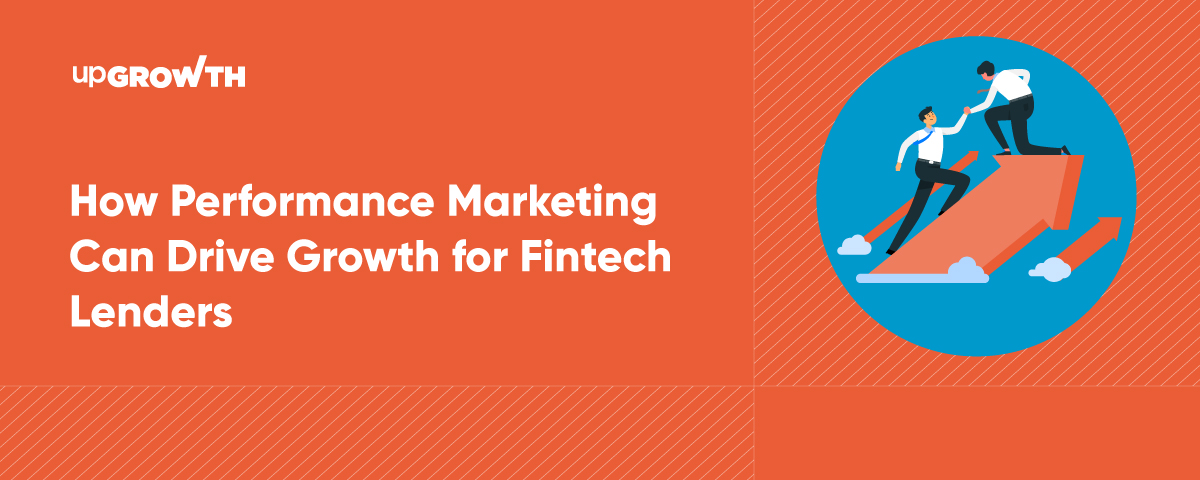How Performance Marketing Can Drive Growth for Fintech Lenders?
Contributors:
Abid Ali
Published: November 29, 2024

Summary
Performance marketing is a cost-efficient, data-driven strategy that helps fintech lenders target, acquire, and retain customers by focusing on measurable actions like clicks, leads, or conversions. Leveraging channels like paid search, social media, affiliate marketing, and programmatic ads, it allows precise targeting and scalability. It addresses challenges like high competition and complex customer journeys while providing tools to track KPIs like CAC, LTV, and ROAS. By personalizing campaigns and adhering to compliance, fintech lenders can boost growth and maximize ROI in a competitive market.
The fintech lending market in India is growing rapidly, yet competition within the space has become intense. How can emerging players stand out, effectively reach their audiences, and drive measurable growth? The answer lies in performance marketing—a data-driven approach to customer acquisition and engagement that ensures marketing efforts deliver tangible results.
Understanding Performance Marketing
What is Performance Marketing?
Performance marketing is a form of digital advertising where brands pay only for specific actions, such as clicks, leads, or conversions. Unlike traditional marketing, where costs are tied to impressions or broad reach, performance marketing aligns your spending with measurable outcomes, making it an ideal approach for fintech startups seeking high marketing ROI.
Key Components of Performance Marketing
- Pay-per-click (PPC) Advertising: Platforms like Google Ads allow businesses to reach high-intent users searching for solutions like yours.
- Social Media Advertising: Facebook, LinkedIn, and Instagram offer performance-based advertising tailored to demographics or interests.
- Affiliate Marketing: Collaborate with partners to drive traffic, paying only for successful leads.
- Programmatic Advertising: Data-driven ad buying ensures your message reaches the right audience in the right place at the right time.
For fintech lenders focused on scalable growth, performance marketing delivers precise targeting, measurable results, and cost efficiency.
The Growing Importance of Fintech Lenders in India
The Landscape
India’s fintech lending ecosystem has seen exponential growth, driven by a tech-savvy population and increasing digital adoption. According to reports, the Indian digital lending market is projected to touch $350 billion by 2023, growing at a CAGR of 22%.
Challenges in Customer Acquisition
However, fintech lenders face several challenges despite this immense potential:
- High Competition: A crowded market makes it challenging to differentiate offerings.
- Retention Issues: Customers often switch between platforms for better rates or features.
- Complex Customer Journeys: The digital-native audience expects seamless, personalized experiences.
Performance marketing acts as a bridge, helping fintech lenders rise above these challenges by focusing on targeted, measurable, and impactful campaigns.
What is the Role of Performance Marketing in Fintech Lending?
Customer Acquisition & Retention
Performance marketing allows fintech lenders to target prospective borrowers with precision. For instance, PPC campaigns can attract users actively searching for “low-interest personal loans,” ensuring qualified leads. Meanwhile, email retargeting campaigns can reactivate dormant customers by offering personalized deals or updates.
Example Campaign:
A fintech lender used Facebook retargeting ads to re-engage users who abandoned their loan application forms. The campaign resulted in a 53% reduction in Customer Acquisition Cost (CAC) and boosted conversions by over 40%.
Advantages for Fintech Lenders
- Cost-Efficiency: Pay only for results, which optimizes limited marketing budgets.
- Scalability: Performance strategies are flexible and can scale with your startup.
- Data-Driven Insights: Analytics provide valuable insights into consumer behaviour and preferences.
Top 5 Key Performance Marketing Channels for Fintech Lenders
1. Paid Search Advertising
- Platforms like Google Ads allow you to advertise using keywords like “quick loans” or “best digital lenders.”
- With intent-driven targeting, you capture users looking for your services.
2. Social Media Advertising
- Channels like LinkedIn are perfect for reaching corporate clients or SMBs, while Instagram targets younger borrowers.
- These platforms offer advanced segmentation based on age, location, interests, behaviour, and more.
3. Affiliate Marketing
- Partner with affiliates who promote your services on their blogs, websites, or newsletters.
- Adjust commissions to pay only for qualified leads or completed loans.
4. Programmatic Advertising
- Automatically buy ad placements using AI to display ads to target audiences efficiently.
- Advanced platforms like The Trade Desk help fintech brands extend their digital reach.
5. Email Marketing
- Nurture leads or retain existing customers with tailored emails highlighting competitive loan rates or new features.
- Incorporate performance tracking like CTR and conversions.
Each channel has unique advantages, and the right mix ensures a comprehensive approach to market engagement.
KPIs to Measure Success
- Conversion Rates: The percentage of users who complete the desired action (e.g., apply for a loan).
- Customer Acquisition Cost (CAC): The total cost of acquiring one customer.
- Lifetime Value (LTV): The total revenue generated from a customer during their lifecycle.
- Click-Through Rates (CTR): The percentage of ad viewers who click through to your website or landing page.
- Return on Ad Spend (ROAS): Revenue generated for every advertising dollar spent.
Tools for KPI Tracking
What are the Challenges in Implementing Performance Marketing?
Performance marketing in fintech isn’t without its hurdles. Common challenges include:
- High Competition in ad space, leading to costly PPC campaigns.
- Compliance Requirements need transparent ad policies and accurate loan disclosures.
- Ad Oversaturation, causing potential borrowers to ignore offers.
- Complex Attribution models make it hard to evaluate ad performance.
Strategies to overcome these challenges include focusing on innovative campaign creatives and leveraging AI tools for attribution modelling.
Personalizing Marketing for Diverse Demographics
Fintech lenders target a wide array of customers—from first-time borrowers to small business owners. Personalization is key to winning trust and engagement.
Personalization Techniques
- Data-Driven Segments: Tailor messaging based on behaviour, demographics, and borrowing history.
- AI and Machine Learning: Predict borrower preferences and recommend products like top-up loans or EMI plans.
- Dynamic Content: Use tools like Unbounce to generate ad content customized for audience segments.
The Role of Technology in Enhancing Performance Marketing
Technology amplifies the impact of performance marketing strategies through advanced tools like:
- CRM Platforms: Centralize and manage customer relationships via Salesforce or HubSpot.
- Marketing Automation Tools: Platforms like Marketo allow optimized and timely campaigns.
- AI and Predictive Analytics: Create hyper-targeted campaigns while forecasting performance outcomes.
These tools streamline processes, reduce manual intervention, and improve overall campaign effectiveness.
Regulatory Compliance in Performance Marketing
The fintech industry is tightly regulated, and performance marketing should uphold principles such as transparency and ethical practices. Key considerations include:
- Transparent Communication about loan terms, rates, and conditions.
- Avoiding Predatory Practices, such as misleading ads about instant approvals.
- Adhering to Data Privacy laws like GDPR or India’s PDP Bill.
Future Trends in Performance Marketing for Fintech Lenders
Looking ahead, innovations shaping the landscape for performance marketing include:
- AI-Driven Personalization for highly tailored user experiences.
- Voice Search Optimization to capture queries like, “What’s the best fintech lender near me?”
- Video & Interactive Ads to engage audiences visually.
- Focus on First-Party Data due to increasing restrictions on third-party tracking.
These trends promise a dynamic future for both fintech and marketing professionals alike.
Boost Your Growth with Performance Marketing
Performance marketing provides fintech lenders in India with a scalable, data-driven way to solve their biggest challenges—from competitive customer acquisition to compliance adherence. By leveraging the right channels and tools, fintech brands can maximize their marketing ROI and position themselves for long-term growth.
Need help creating and implementing a powerful performance marketing strategy? Contact upGrowth today! Our experts specialize in helping fintech lenders achieve measurable results while navigating regulatory complexities.
Frequently Asked Questions
1. What is performance marketing?
Performance marketing is a strategic approach where advertisers only pay for specific actions, such as clicks, impressions, or conversions, rather than upfront costs. It is highly data-driven, allowing fintech lenders to measure the success of their campaigns accurately and optimize costs effectively.
2. What are performance marketing channels?
Performance marketing channels include platforms and strategies like Pay-Per-Click (PPC) ads, social media advertising (e.g., Facebook, Instagram), affiliate marketing, email marketing, and search engine marketing (SEM). Each channel offers unique benefits depending on the fintech lender’s target audience and goals.
3. What are the key performance indicators (KPIs) for measuring the success of performance marketing in the fintech lending space?
Key KPIs include:
- Conversion Rates: The percentage of users completing a desired action (e.g., loan application submissions).
- Customer Acquisition Cost (CAC): The cost incurred to acquire a single customer.
- Lifetime Value (LTV): The total revenue generated from a customer over their lifecycle.
- Click-Through Rates (CTR): The proportion of clicks an ad receives compared to its impressions.
- Return on Ad Spend (ROAS): The revenue earned per dollar spent on advertising.
4. How do different performance marketing channels compare in terms of effectiveness for fintech lenders?
Each channel offers distinct advantages based on the campaign goals:
- PPC and SEM Ads: Effective for high-intent users searching for specific fintech services.
- Social Media Advertising: Engages users through creative content and enables precise targeting based on demographics and behaviours.
- Email Marketing: Retains existing customers with personalized offers and product updates.
- Affiliate Marketing: Expands customer reach via partnerships with publishers or bloggers.
A mix of channels ensures a well-rounded strategy, balancing customer acquisition and retention.
5. What challenges do fintech lenders face when implementing performance marketing strategies?
Common challenges include:
- High Competition: Ad spaces are crowded, leading to increased costs.
- Compliance Requirements: Ensuring all advertising practices align with regulatory policies.
- Ad Oversaturation: Overexposure causes users to ignore repetitive messaging.
- Attribution Complexity: Tracking and analyzing performance across multiple touchpoints.
6. How do fintech lenders personalize their marketing strategies to different demographic segments?
Fintech lenders use data analytics and AI to customize their messaging and offers. Techniques include:
- Segmenting Audiences: Creating targeted campaigns based on user demographics, histories, and preferences.
- AI and Machine Learning: Predicting borrowers needs to deliver tailored product recommendations.
- Dynamic Content Tools: Crafting audience-specific content across platforms for higher engagement.
7. What role does technology play in enhancing the performance marketing efforts of fintech lenders?
Technology is pivotal for fintech lenders to succeed in performance marketing. Key tools include:
- CRM Systems: Manage customer relationships more effectively.
- Marketing Automation Platforms: Automate and optimize outreach efforts for better efficiency.
- AI and Predictive Analytics: Help forecast campaign outcomes and create hyper-targeted ads, significantly boosting ROI.
8. How do fintech lenders ensure compliance with regulatory requirements in their performance marketing campaigns?
Compliance is achieved by adhering to the following:
- Transparent Communication: Clearly detailing loan terms, rates, and conditions in all marketing efforts.
- Avoiding Misleading Practices: Ensuring ads don’t overpromise or misrepresent approval processes.
- Data Privacy Laws: Strictly following regulations like GDPR or India’s PDP Bill to protect customer information.
9. What future trends are anticipated in performance marketing for fintech lenders?
Emerging trends in performance marketing include:
- AI-Driven Personalization: Hyper-customized user experiences based on predictive data.
- Voice Search Optimization: Tapping into voice-enabled fintech queries with optimized campaigns.
- Video and Interactive Ads: Enhancing user engagement through immersive content.
- First-Party Data Focus: Shifting to first-party data collection as third-party tracking restrictions increase.
These trends indicate an exciting future for fintech lenders, offering innovative ways to enhance their marketing efforts and drive sustainable growth.
About the Author
Associate Copywriter
Abid Ali is an Associate Copywriter at upGrowth, where he plays a key role in supporting diverse marketing projects with his knack for creating engaging and persuasive content. With a sharp eye for detail and a passion for storytelling, Abid collaborates closely with the team to bring innovative ideas to life, ensuring every campaign resonates with its audience. His dedication to crafting impactful messaging reflects his growth-oriented mindset and commitment to excellence.
 Growth Strategy and Planning
Growth Strategy and Planning Inbound Growth
Inbound Growth Growth Hacking
Growth Hacking Search Engine Optimization
Search Engine Optimization Paid and Performance Marketing
Paid and Performance Marketing Social Media Marketing
Social Media Marketing AI-Driven Growth Strategy
AI-Driven Growth Strategy AI-Native Workflow Automation
AI-Native Workflow Automation Generative Engine Optimization
Generative Engine Optimization
 Marketing Decision Tree
Marketing Decision Tree Tools
Tools Growth Tools
Growth Tools Offers
Offers Quizzes
Quizzes Insights
Insights

















Leave a Reply